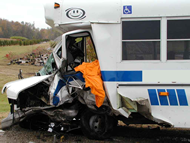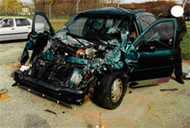29th Annual RESNA Conference Proceedings
Use and Performance of Occupant Restraint Systems for Wheelchair Users in Real-World Crashes
Kathleen D. Klinich, PhD, Jamie L. Moore, Miriam A. Manary, MSE, Lawrence W. Schneider, PhD
University of Michigan Transportation Research Institute
ABSTRACT
Detailed information on 22 real-world crashes involving 23 wheelchair-seated occupants was compiled from new crash investigations and existing crash databases. For 21 occupants, the wheelchair tiedowns were used correctly and successfully secured the wheelchair during the crash event. However, results of these investigations show that only nine case occupants were using a crash-tested lap/shoulder belt restraint. Many wheelchair-seated occupants failed to use shoulder belts, wore the belt restraints loose or improperly positioned because of interference with wheelchair components, or used only postural belts that were not designed to provide effective restraint in a crash. Summaries of three cases are presented that show the adverse consequences of these restraint usage issues.
KEYWORDS
Motor vehicle crashes, Wheelchair-Seated Occupants, Wheelchair Tiedowns, Occupant Restraints
BACKGROUND
For people who remain seated in their wheelchairs in motor vehicles, safe travel requires the use of an aftermarket crash-tested wheelchair tiedown and occupant restraint system (WTORS). The WTORS must secure the wheelchair so that its mass will not load the occupant. It must also restrain the occupant to prevent ejection from the vehicle and minimize injurious contact with the vehicle interior during crashes and emergency maneuvers. Traveling safely also requires a wheelchair designed to provide crashworthy seating in a motor vehicle that allows proper use and positioning of both lap and shoulder belt restraints.
In the absence of federal safety standards to address these issues, voluntary standards have been developed to evaluate the design and crashworthiness performance of WTORS and wheelchairs. These include Society of Automotive Engineers (SAE) J2249 Wheelchair Tiedown and Occupant Restraint Systems for Use in Motor Vehicles and Section 19 ANSI/RESNA WC/Volume 1 (or WC/19) Wheelchairs for Use as Seats in Motor Vehicles . Both standards require products to be crash-tested in a 48-kph, 20- g frontal sled impact test. WC/19 also requires that wheelchairs provide four accessible attachment points for use with a four-point strap-type tiedown system that complies with SAE J2249. In addition, WC/19 requires that wheelchairs be rated with regard to how easily they accommodate proper use and positioning of vehicle-anchored lap and shoulder belts to restrain the wheelchair user.
While these standards are based on the fundamental principles of occupant protection, it is important to examine real-world crashes involving wheelchair-seated drivers and passengers to provide guidance for research and the development of future standards that will further improve transportation safety for wheelchair users. Toward this end, the Rehabilitation Engineering Research Center on Wheelchair Transportation Safety (RERC on WTS) has initiated a task to collect and compile crash/injury data from real-world events involving wheelchair-seated drivers and passengers. This paper describes some of the results of this task to date, with a particular focus on issues related to the use and performance of occupant restraint systems.
METHODS
Crashes involving wheelchair-seated occupants were identified through news reports and responses to advertisements in law enforcement publications. If the occupants involved in the crash agreed to participate in the research study, a detailed crash investigation was performed.* These investigations involve measurement and photographic documentation of vehicle exterior and interior damage, inspection of the involved wheelchair and WTORS for usage and crash-related damage, inspection of the crash scene, interviews with vehicle occupant, and, when appropriate, collection of detailed injury data.
RESULTS
Summary of UMTRI Crash/Injury Database for Wheelchair-Seated Occupants
 Figure 2. Wheelchair secured in docking tiedown device following the frontal crash of case WC-001. (Click image for larger view)
Figure 2. Wheelchair secured in docking tiedown device following the frontal crash of case WC-001. (Click image for larger view)
Of the 22 crashes in the UMTRI wheelchair-occupant database, 16 are frontal impacts, one is a side impact, two are rollovers, and three involved multiple impacts. The severity of the crash event was considered to be high in six cases, moderate in seven cases, low in seven cases, and unknown in two cases. The vehicle was a full-size van in twelve cases, a minivan in eight crashes, and a bus in two cases. The wheelchair-seated occupant was the driver in eight cases, and all of the drivers' wheelchairs were secured to the vehicle using docking-type tiedown devices. One wheelchair-seated passenger was in the right-front seating position, nine were in the second row, two were in the third row, and three were in the fourth row. All wheelchairs were forward-facing. All of the passengers' wheelchairs were secured to the vehicle by four-point, strap tiedown systems, except for one case where the wheelchair was secured by only a single tiedown strap attached to the right-front vehicle seat. All of the four-point tiedown systems secured the wheelchair during the crash except for one severe rollover case, in which the tiedown track pulled up from the floor of the van.
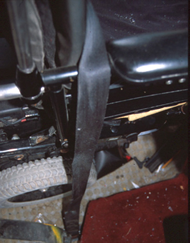 Figure 3. Shoulder belt improperly routed over right wheelchair armrest in case WC-001. (Click image for larger view)
Figure 3. Shoulder belt improperly routed over right wheelchair armrest in case WC-001. (Click image for larger view)
Seven occupants were restrained by a lap/shoulder belt and two occupants were restrained by both a lap/shoulder belt and an airbag. One driver was restrained by only an airbag and reportedly did not use the available three-point belt because she could not reach the buckle receptacle that was mounted near the floor. Two occupants were restrained by only postural belts attached to the wheelchair, and both indicated that they were unaware that these belts would not offer sufficient restraint in a crash. Restraint use for three occupants is unknown and two occupants were unrestrained. Four occupants were using only a vehicle-anchored lap belt, and three of these occupants with loose and high routing of the lap belt died from thoracic and/or abdominal injuries caused by lap-belt loading. One occupant was restrained by an airbag and a shoulder belt, while another driver was restrained by only an improperly routed shoulder belt. Seven wheelchair-seated occupants died in these crashes, two sustained severe injuries but survived, ten sustained minor-to-moderate injuries, and four were uninjured.
Descriptions of Selected Cases
WC-001: In this severe frontal impact, the front of a 1992 Ford Econoline-150 modified van struck the front of a 1992 Chevrolet K-1500 pickup truck after a tire blow out and caused the van to cross the centerline on a two-lane road. The maximum crush of the case vehicle was 69 cm. The crash severity, evaluated using the change in velocity (delta V) of the van during the impact, was estimated to be 36 mph. The van driver was a 32-year-old male who was seated in a powered wheelchair secured by a docking tiedown device. He was restrained by a postural lap belt anchored to the wheelchair and a vehicle-anchored shoulder belt routed over the right armrest of the wheelchair that had been modified with safety pins to facilitate positioning. During the frontal crash, the docking tiedown device deformed significantly but did not release the wheelchair. However, the driver sustained numerous and fatal thorax and abdomen injuries from loading by the loose and poorly positioned shoulder belt.
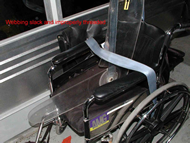 Figure 5. Improper routing of lap belt used without a shoulder belt in case WC-006. (Click image for larger view)
Figure 5. Improper routing of lap belt used without a shoulder belt in case WC-006. (Click image for larger view)
WC-006: This case involved a 1998 Ford F-350 van that was involved in an offset-frontal crash with a 1991 Oldsmobile Ninety-Eight four-door sedan that had crossed the centerline. The maximum crush of the case vehicle was 146 cm and the estimated delta V was 34 mph. The case occupant is a 77-year-old female who was seated in a manual wheelchair secured facing forward in the right second row by a four-point, strap-type tiedown. She was not using an available two-point shoulder belt, reportedly because it rubbed against her neck, and the floor-anchored lap belt was routed over the armrests of the wheelchair. During the frontal crash, the wheelchair occupant moved forward into the improperly and loosely positioned lap belt, resulting in multiple thoracic and abdominal injuries that caused her death at the scene.
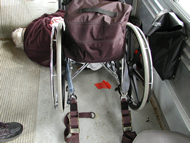 Figure 6. Tiedowns and post-crash location of fatally injured occupant in case WC-006. (Click image for larger view)
Figure 6. Tiedowns and post-crash location of fatally injured occupant in case WC-006. (Click image for larger view)
WC-014: In this crash, the front of a 1996 Ford Windstar struck the rear of a school bus. Several minutes later, the Windstar was struck in the rear by a 1982 Buick Skylark sedan. The maximum crush and estimated delta V from the frontal impact are 78 cm and 19 mph, respectively. The driver of the case vehicle was a 26-year-old female seated in a powered wheelchair that was secured by a docking-type tiedown device. She was not using the vehicle-anchored three-point belt because she could not reach the inboard buckle, but the steering-wheel airbag deployed. During the frontal impact, she moved forward into the deploying airbag and was then ejected from her wheelchair into the second-row area during the rear impact. She sustained multiple and fatal thoracic injuries, including aortic rupture, that were most likely caused by close-proximity airbag loading to her chest because of the lack of a belt restraint.
DISCUSSION AND CONCLUSIONS
In developing WC/19 Wheelchair Used as Seats in Motor Vehicles , interference of wheelchair components, such as armrests and wheels, with the easy use and proper positioning of vehicle-anchored belt restraints was recognized as a barrier to providing effective occupant protection for wheelchair-seated occupants. Annex E addresses this issue by evaluating and rating wheelchairs using an eight-point scoring system for their ability to allow proper positioning of a vehicle-anchored three-point belt easily on the wheelchair user. Unlike other parts of WC/19, such as results of the frontal-impact test, this evaluation does not involve a pass/fail criterion, but the rating of good, acceptable, or poor must be disclosed in the wheelchair manufacturers' presale literature.
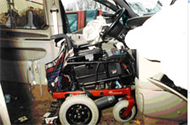 Figure 8. Wheelchair and deployed airbag after the frontal crash and rear impact of case WC-014. (Click image for larger view)
Figure 8. Wheelchair and deployed airbag after the frontal crash and rear impact of case WC-014. (Click image for larger view)
The results of the current RERC-WTS study of real-world crashes involving wheelchair-seated occupants indicate that most crash-related injuries to wheelchair-seated occupants result from improper use of belt restraints. Belt restraints are not used properly because they are uncomfortable, they are difficult to position properly because of interference with wheelchair components, or because users are unaware of what constitutes proper restraint. These findings emphasize the importance of the WC/19 test for wheelchair accommodation of belt restraints, as well as the importance of providing wheelchair users with the option of using a wheelchair-anchored lap belt, which is also required by WC/19. They also suggest that awareness and enhancement of these parts of WC/19 should be continued and strengthened in the future.
REFERENCES
- American National Standards Institute/Rehabilitation Engineering and Assistive Technology Society of North America (ANSI/RESNA). (2000). Section 19 ANSI/RESNA WC/Volume 1: Wheelchairs Used as Seats in Motor Vehicles . Arlington , VA
- Society of Automotive Engineers (SAE). (1999). Recommended Practice J2249 Wheelchair Tiedown and Occupant Restraint Systems for use in Motor Vehicles. In SAE Handbook 2002 pp. 229-244. Warrendale , PA
ACKNOWLEDGEMENTS
This study was funded by the National Institute on Disability and Rehabilitation Research (NIDRR) and the Rehabilitation Engineering Research Center (RERC) on Wheelchair Transportation, grant # H133E010302. The opinions expressed herein are those of the authors and are not necessarily reflective of NIDRR opinions.
Contact information:
Kathleen D. Klinich
Biosciences Division
University of Michigan Transportation Research Institute
2901 Baxter Road
Ann Arbor , MI 48109
(734) 936-1113
kklinich@umich.edu
This should be in the right column.

